Film Eye: The Wind that Shakes the Barley
Published in 20th-century / Contemporary History, Issue 5 (Sep/Oct 2006), Reviews, Revolutionary Period 1912-23, Volume 14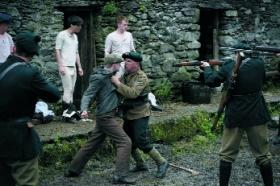
Black and Tans rough up the locals.
The Wind that Shakes the Barley
Director: Ken Loach
by Brian Hanley
Film reviews by historians should carry a warning. Aside from the array of personal, political and other prejudices that all reviewers bring to bear on their subject, there is the fact that most historical films will influence far more people’s view of history than any book, article or review that we will ever write. As a result we can tend to be a bit jealous and pedantic in our criticisms. The huge impact of Neil Jordan’s Michael Collins has been brought home to me on dozens of occasions as students have confidently assured me of some event or speech which on further investigation turns out to have been a scene from that movie.
By the time this review appears I suspect that most of History Ireland’s readers, at least those living in Ireland itself, will have seen Ken Loach’s drama The Wind that Shakes the Barley. Telling the story of two Cork brothers, Teddy and Damien O’Donovan (Padraic Delaney and Cillian Murphy), during the War of Independence and the Civil War, the film has been a massive commercial success in Ireland, as well as winning the Palme d’Or at Cannes. Perhaps inevitably it has drawn comparison with Michael Collins, which ten years ago was released to a similar chorus of ill-informed and at times hysterical condemnation—ill-informed because in the case of much of the early commentary on both films the ‘reviewers’ had not actually seen them. There the comparison between the two films ends, however, because while Michael Collins was historically weak, often misleading and grossly biased, The Wind that Shakes the Barley is on much surer ground historically.
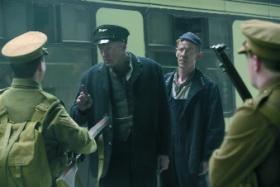
Train driver Dan (Liam Cunningham) and stoker (Peter O’Mahoney) refuse to allow British troops onto the train. For many film-goers it will be the first time they have been informed that there was a trade union boycott of British military transport.
Loach clearly benefited from the expertise of Donal Ó Drisceoil as historical adviser, and rural Cork in the revolutionary era is recreated vividly. In terms of Loach’s work it resembles most closely his 1995 Spanish Civil War drama Land and Freedom.
Much of the criticism of the film in Britain centred on the portrayal of British state violence. There is no doubt that the Black and Tans are shown as brutal and this may surprise some people in Britain, but in Ireland, to put it mildly, it is hardly controversial. In fact The Wind that Shakes the Barley is much more concerned with the conflict that emerges among the Irish revolutionaries. Almost everyone I have spoken to about the film has commented on the emotional impact of the Civil War division rather than the War of Independence sequences. This presumably reflects the fact that not too many people, in nationalist Ireland at least, expect the Tans to be anything other than thugs but that there is much more confusion about the causes and course of the Civil War. And unlike Michael Collins, which put this conflict largely down to de Valera’s devilish jealousy of Collins, Loach’s film shows that there were more complex forces involved.
In that sense the film bears comparison with Ronan Bennet’s TV series Rebel Heart (2001), in which a young middle-class republican is also converted to socialism by a Citizen Army man. In Rebel Heart it is the ICA man who ends up in Free State uniform, but the narrative of betrayal and class conflict is similar. Latterly critics, having realised that lamenting the lack of sympathetic Black and Tan characters is probably not going to put too many people off the movie, have focused on the socialist aspect of the plot. This has been described as unrealistic and as the imposition of a British Marxist fantasy onto a purely nationalist phenomenon.
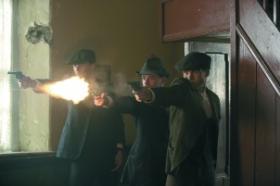
Teddy (Pádraic Delaney), Steady Boy (Aidan O’Hare) and Damien (Cillian Murphy) ambush Black and Tans in a pub.
But the reality is that strikes, workplace seizures and land agitation were rife during the revolutionary period in Ireland. It was an era of intense class conflict, not all of it connected to the war against the British, and it is an aspect of the period that is relatively little known in popular terms, either here or in Britain. It is to Loach’s credit that he has illustrated this on the big screen and drawn attention to this aspect of the revolution. For many film-goers it will be the first time they have been informed that there was a trade union boycott of British military transport, that Sinn Féin courts existed and that sometimes IRA volunteers enforced landlord’s edicts. The character of Dan (Liam Cunningham), the Dublin ICA veteran and trade unionist, has been criticised as contrived, as if travel between Dublin and Cork was unknown in 1920! In fact labour radicals like Seán McLaughlin and Roddy Connolly were active across Ireland; there was an ICA unit in Monaghan town.
More problematic is the way Loach makes the socialist argument the centre of the debate over the Treaty. Most contemporary republicans did not view the debate in those terms. Here Loach is guided by his view that it was the Democratic Programme of the First Dáil that informed the social thinking of the revolution. The reality was that remarkably little attention was paid to the programme at the time. It was in defeat that Liam Mellows and others drew the conclusion that the ‘stake in the country’ people had betrayed the revolution.
Part of the film’s popularity in Ireland may be due to the fact that it is possible to draw conflicting conclusions from the arguments portrayed in the film. The audience is invited to judge for themselves whether ‘the Ireland that we’re fighting for’ was ‘worth’ the execution of a teenage informer, or whether, as the unionist landlord predicts, the result was ‘a priest-infested backwater’. Some will conclude that yes, indeed, the violence, however terrible, was worth it and that the Ireland that emerged was nothing like the prediction.
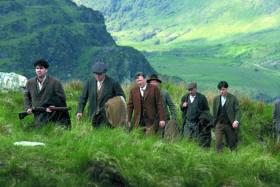
The flying column accompany loyalist landlord, Sir John Hamilton (Roger Allam, centre), to his place of execution.
When the O’Donovan brothers argue on the church steps about what land redistribution would mean for their uncles’ farms it is perfectly possible to conclude that either view is a valid one. Hence, perhaps strangely, Loach’s film is acceptable to almost as broad a range of nationalist opinion as was Michael Collins; Fianna Fáil, Fine Gael and Sinn Féin reviewers have all claimed to like it, and indeed they all probably did. This is more a reflection of the flexibility of Irish nationalism than of Loach’s film but contrasts strongly with the reaction to Land and Freedom, which sharply divided the left. The Wind that Shakes the Barley’s well-produced and illustrated screenplay contains an intriguing scene, not included in the film, where the landlord is being held in a hillside cottage and class and religious tensions are given expression in a discussion between the poor smallholder, the volunteers and their prisoner. One of the volunteers threatens to ‘throttle the Protestant bastard’ and is rebuked by Dan, who points to portraits of Emmet and Tone on the walls. This scene would have introduced a further complexity to the film and was worthy of inclusion.
Finally, the inevitable pedantic points. Nobody called the British Army ‘the Brits’ in 1920s Ireland. The term itself is a British tabloid creation, as in ‘the Brits abroad’, and only came into use among Irish nationalists in the 1970s. Secondly, British soldiers would not have carried their rifles in the manner depicted in the film, stock cradled over elbow; that practice belongs to the modern era and modern weaponry, and while it is a correct depiction of a foot patrol in Belfast or Basra it is not of one in Bandon during 1921.
Brian Hanley lectures in Irish history at Trinity College, Dublin.
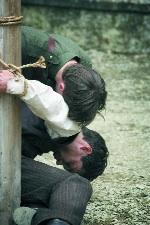
Free Stater Teddy grieves over the body of Damien, his anti-Treaty brother, following his summary execution.
(All images Pathé Films)
















